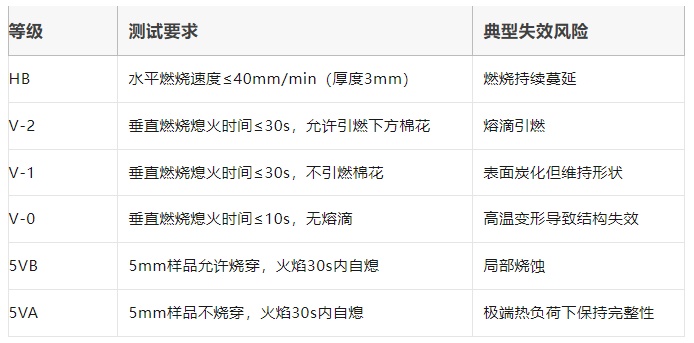TPE Flame Retardant Requirements and Flame Retardant Usage Across Different Application Fields

I. UL94 Standard Classification and Core Indicators

2. Application Guide for Flame Retardants in Different Fields
HB Grade (Standard Packaging/Regular Toy)
Requirement: Pass UL94 HB test (horizontal burning rate ≤ 40 mm/min)
Plan: Add 15% phosphorus-based (such as TPP) or inorganic flame retardant (aluminum hydroxide).
Advantage: Lowest cost, meets basic flame retardant requirements
V-2 Level (Non-critical Electronic Components/Children's Toys)
Requirement: Pass the UL94 V-2 test (vertical self-extinguishing ≤ 30s, dripping allowed)
Plan: Add 20-30% phosphorus-nitrogen composite flame retardant (APP+MPP 3:1)
Note: Must comply with EN71-3 toy safety standards.
V-1 Level (Automotive Interior/Sealing Parts/Home Appliance Shell)
Requirement: Pass the UL94 V-1 test (vertical burn self-extinguishing ≤30 seconds, no ignition of cotton).
Add 15-25% microencapsulated nitrogen and phosphorus flame retardant masterbatch (EVA carrier).
Add 1-2% charring agent (pentaerythritol) to suppress dripping.
V-0 level (electronic connectors/cables/medical devices)
Requirement: Pass the UL94 V-0 test (vertical burning time ≤10 seconds, no dripping).
Plan: Add 20% PPO (polyphenylene oxide)
Characteristics: Simultaneously enhance flame retardancy (OI≥28%), heat resistance (HDT≥120℃), and strength.
Disadvantage: Material costs increase by 35-50%
Restrictions on the Use of Halogen Flame Retardants
Advantage: Achieving V-0 rating with the addition of only 5-10% brominated flame retardant, with costs 40% lower than halogen-free solutions.
Risk: The EU RoHS restricts substances such as decabromodiphenyl ether, which produce toxic smoke when burned (fails IEC 60754 test).
Key Measures for Performance Balancing
Blending SEBS substrates with high and low molecular weight grades (such as YH-503T, 533, 602T, 604T)
·Compound high-flow grades (such as YH-688, 506, 502T)
Flame retardants cause a decrease in the flowability of TPE (MI reduced by 30-50%).
Taboo: SEBS oil content > 40% will significantly reduce flame retardant efficiency.
【Copyright and Disclaimer】The above information is collected and organized by PlastMatch. The copyright belongs to the original author. This article is reprinted for the purpose of providing more information, and it does not imply that PlastMatch endorses the views expressed in the article or guarantees its accuracy. If there are any errors in the source attribution or if your legitimate rights have been infringed, please contact us, and we will promptly correct or remove the content. If other media, websites, or individuals use the aforementioned content, they must clearly indicate the original source and origin of the work and assume legal responsibility on their own.
Most Popular
-

List Released! Mexico Announces 50% Tariff On 1,371 China Product Categories
-

Nissan Cuts Production of New Leaf EV in Half Due to Battery Shortage
-

New Breakthrough in Domestic Adiponitrile! Observing the Rise of China's Nylon Industry Chain from Tianchen Qixiang's Production
-

Dow, Wanhua, Huntsman Intensively Raise Prices! Who Controls the Global MDI Prices?
-

Mexico officially imposes tariffs on 1,400 chinese products, with rates up to 50%






